

 The South African
The South African
D C Panagos
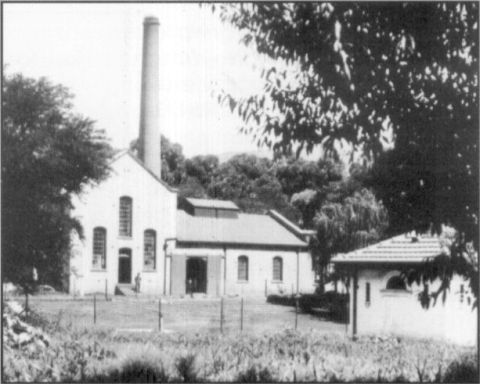
The British-built pump station that sent water to the
cantonment known as Roberts Heights. The boiler room is on the right.
(Courtesy: the City Council of Pretoria ).
The two springs in the Fountains Valley immediately to the south of Pretoria were certainly the reason why the early settlers, the Bronkhorst brothers, selected this position to establish their own farm and eventually, to convince the Voortrekker leaders to move their seat of government from Potchefstroom to Pretoria. These two fountains are completely independent of each other, being separated by a dyke. Both produce an abundance of very pure water from the dolomitic formation between Pretoria and Irene. To ensure this vital supply for the town, the Volksraad of the ZAR bought the area of the springs from the Bronkhorsts on 20 August 1863. However, legal wrangling went on for many years before the supply was assured.
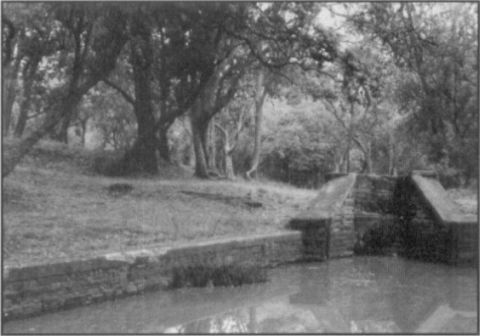
The neat masonry funnel leading to the sump at the chamber. (Photo by the author, 1990).
Originally the water was led to Pretoria along open furrows. Many of the cement pavements in Du Toit, Paul Kruger, Andries, and Bosman streets still cover these slate-lined 'sloets'. Despite the fact that most of the townspeople had their own wells, repeated epidemics of typhoid eventually convinced the Volksraad that water should rather be piped to the town.
This project was placed in the hands of the Pretoria Waterleiding Maatschappy. Since the water was delivered by gravity from the springs, there was no need for a pump, and the first areas to receive this water were Trevenna and Harmony. Not all was quite harmonious, however, judging by the complaints from the citizens of the town. In fact, much later, during the 1st AngloBoer War, the British Military Governor issued an order of the day stating that beer was not to be obtained from the Trevenna Brewery because the pipes had rusted and the water was contaminated. This must have been very unpopular with the soldiers, who had probably thought that it was just an acquired taste.
A little later, in 1902 during the British occupation, the decision was taken to erect a pumping station at the Fountains Valley, not to pump water to the longsuffering citizens of Pretoria, but rather to 'the military'. In a letter to the Commissioner of Lands, Pretoria, the Secretary of the Law Department writes that ' ... a portion of the land (Groenkloof) may be made over for the purpose of a pumping station for the military', meaning that water would be pumped to the new cantonment at Quaggapoort, known in 1902 as Roberts' Heights.
The machinery, a steam pump, was to be able to deliver 200 000 gallons (900 000 litres) of water a day. The pump house still stands in the valley, but the steam engine has been replaced by electric motors. Unfortunately, when this change was made the boiler room and its tall chimney were thoughtlessly demolished. It is certain, however, that this was actually not the first water pump to be erected in the valley. After the Jameson Raid, the Volksraad decided to build four forts to defend Pretoria, and the German designers needed to provide the cisterns in the forts with water. In the case of the forts Schanskop and Klapperkop, situated on the hills to either side, this had to be pumped up from Fountains Valley. In 1898, Lieutenant du Toit of the Staatsartillerie reported that ' ... die machienen by die Fonteinen het water oppompt naar die forte Schanskop en Klapperkop'. (State Archives, KG Ref CR6473/ 98).
The remains of this ZAR pumping station can be seen immediately to the south of the swimming baths at the resort. It consists of a concrete dam wall topped by a steel rim. On the north side of the dam, there is a masonry funnel leading to a sump chamber which is protected by two filters. One consists of a coarse grid of heavy steel bars. The second is a steel plate drilled with small holes. The west wall also comprises neat masonry. The south retaining wall was destroyed in the 1960s or 70s when a road was built on that side.
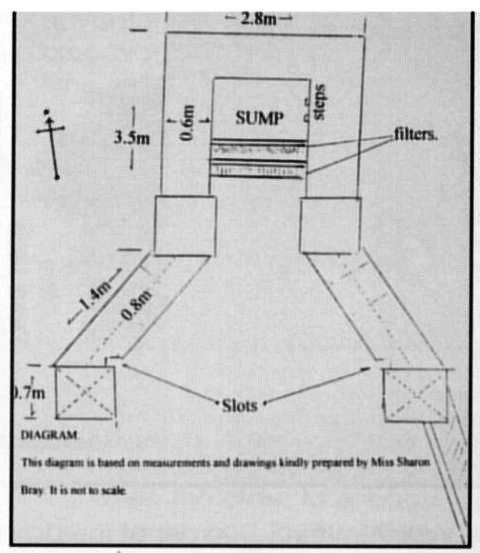
This diagram is based on measurements and drawings kindly prepared by Sharon Bray. It is not to scale.

Detail of the coarse and fine steel filter plates. Note the steel steps set into the masonry.
All the work, except for the top of the sump where the water pump stood, had neat coping stones. The two funnel plinths had pyramidal capstones. The photograph above shows how the coping stones were keyed in together. Steel steps are set into the stonework on the east side of the sump to enable workmen to climb down inside the sump to clear out accumulations of silt when required.
For this work to be done, it would have been necessary to shut off the sump from the dam, and two slots behind the lower plinths would have held a large wooden shutter that would have been lowered for this purpose. The eastern slot can be seen next to the lower plinth in the photograph above. There is an interesting feature on the steel rim of the dam wall, a 90° 'V' cut into the steel. This was the water flow gauge. (see photograph below). The height of the water, 'H', above the apex of the V was measured in inches and the formula, flow of water = height (H) squared times the square root of height (H) divided by 200, gave the flow of water in cubic feet per second.
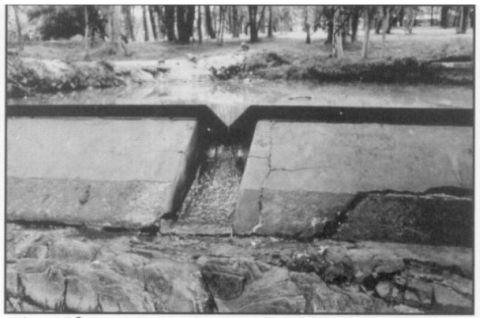
The 90° V cut into the steel rim is the water flow gauge. (Photo: DC Panagos, 1990).
After the occupation of Pretoria by Lord Roberts, the four forts were garrisoned by regiments of the British Army. The Royal Engineers also had a close look at the forts, and of course continued to use the original ZAR pumping station for the water supply. A report by the engineer officer describes the pump as a 'Horizontal Worthington'. It was driven by either petrol or paraffin, and was probably covered by a wood and iron shed. However, the commander of the Royal Engineers in Pretoria, Colonel Maxwell RE, was soon reporting that there were serious and repeated shortages of water at two of the forts owing to some unspecified problems at the' ... pumping station at Groenkloof'. Whether this was owing to faults occurring in the pumping machinery, or more probably, to the continual silting-up of the sump, is not clear. The heavy burden of brown silt is evident in the accompanying photographs.
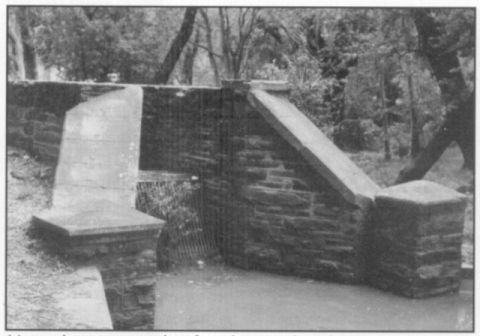
Note the eastern slot for the wooden shutter behind the plinth. The coping stones and the pyramidal capstone on that side have been vandalised since 1990. (D C Panagos, 1990).
The neatly dressed, pointed masonry and the coping stones on the walls are quite clearly contemporary with the style of construction of both forts, Schanskop and Klapperkop. The photographs taken in 1990 show that the coping stones and the pyramidal capstones on the lower plinths were still present. Unfortunately, mindless vandalism has been taking place since then and many of these stones have now been prised loose and thrown into the nearby stream.
Most of them can still be recovered, including the pyramidal capstone from the eastern plinth. Both the forts at Klapperkop and Schanskop have been declared Heritage Sites. This article proposes that the ZAR pumping station in the Fountains Valley, which is associated with them, and which was so vital to the existence of the forts, should receive the same protection as the forts themselves. They should be restored.
Return to Journal Index OR Society's Home page
South African Military History Society / scribe@samilitaryhistory.org